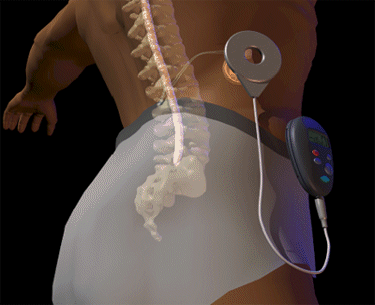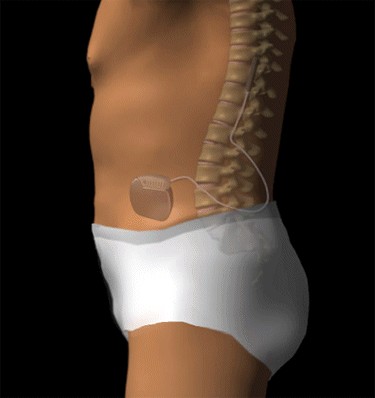Radio Frequency (RF) vs. Implantable Pulse Generator (IPG) Neurostimulation Systems
The relative merits of radio frequency (RF) versus internally powered implantable pulse generator (IPG) systems are often debated. Their efficacy can vary from one patient to another, from one area of the body to another, and from one disease state to another.
The Figure shows that the two designs have many similarities, but there are important distinctions that patients and clinicians should consider when determining which is best suited for an individual patient's needs. A brief summary of the similarities between the two types of systems, as well as the advantages and disadvantages of each, appears below.
Similarities
- Patient can control the intensity of stimulation in order to optimize the dose of stimulation
- Electrode placement options for both systems include percutaneous electrodes (inserted through a needle) as well as electrodes implanted surgically.
- Screening process is similar
- Implant techniques are similar
- Research is needed to determine if the incision required to place the power source, whether IPG or RF receiver, can result in spread of the RSD to that previously non-painful part of the body.
- Implantation of either the IPG or RF systems will preclude the use of MRI for diagnostic studies in the future because both systems contain metal.
Advantages
| Radio Frequency Systems | Implantable Pulse Generators | - External power source does not require surgical replacement for battery depletion (which reduces chances of losing the stimulator to infection, as each operation multiplies that risk).
- Capability for high frequency settings and power output may provide improved pain relief in patients with RSD
- Multiple electrodes with more contacts, potentially decreasing the need for revisions while increasing area(s) of pain coverage*
- Patient control includes all parameters of stimulation, in particular electrode contact combinations, allowing more versatile, patient-interactive therapy*
- The implant is slightly smaller in size and weighs less.
| - No requisite external antenna may provide less interference with lifestyle.
- Ease of use, fewer and simpler controls
|
Disadvantages
| Radio Frequency Systems | Implantable Pulse Generators | - Potential irritation of the skin at the site of antenna placement (especially in warm climates or in sensitive patients) may compromise therapy
- Inability to use the system while showering, bathing, or swimming
- Transmitter and antenna may limit choices of clothing
- Potential difficulties in communication between the antenna and the implanted receiver, particularly in obese patients
- Requires frequent replacement or recharging of external transmitter's battery
| - Implanted battery requires periodic surgical replacement of the device
- Limitation of frequency levels and power output
- Fewer electrical points along the electrode (electrical combinations) for stimulation may be available for stimulation.
- Therapy may be compromised due to limitations of power output and need for battery conservation
|
* Certain differences between presently available devices are not inherent in all (or intrinsic to all) RF vs. IPG designs. New designs may overcome these limitations, and may provide new options (e.g., rechargeable implanted power sources).
RSD/CRPS is sometimes a migratory or progressive disease: Pain may begin in one area or extremity, only to spread and involve other extremities. This progression can significantly increase the power and electrode requirements.
As a general rule, patients with single extremity pain would be the most appropriate candidates for an IPG system; the energy requirements are low, and application of an antenna to a possibly sensitive implant site is avoided. Upper extremity pain problems, which may involve the extremity used to control the implant, may benefit from the simpler controls of present IPG's available on the market. Patients with lower extremity and multiple extremity pain, on the other hand, may require the RF system that can operate at higher intensity levels and disperse stimulation to multiple distinct parts of the body.
An informed choice of SCS system by the patient and physician should be made after considering the patient's current pain patterns and the possibility of progression of the RSD, and the pertinent differences between RF and IPG systems.
External Battery System
Radio Frequency (RF) System

Internal Battery System
Implantable Pulse Generator (IPG) System
 |
HOME | MENU | DONATE | CONTACT US
Copyright © 2003 International Research Foundation for RSD/CRPS.
All rights reserved.
For permission to reprint any information on the website, please contact the Foundation.
|

